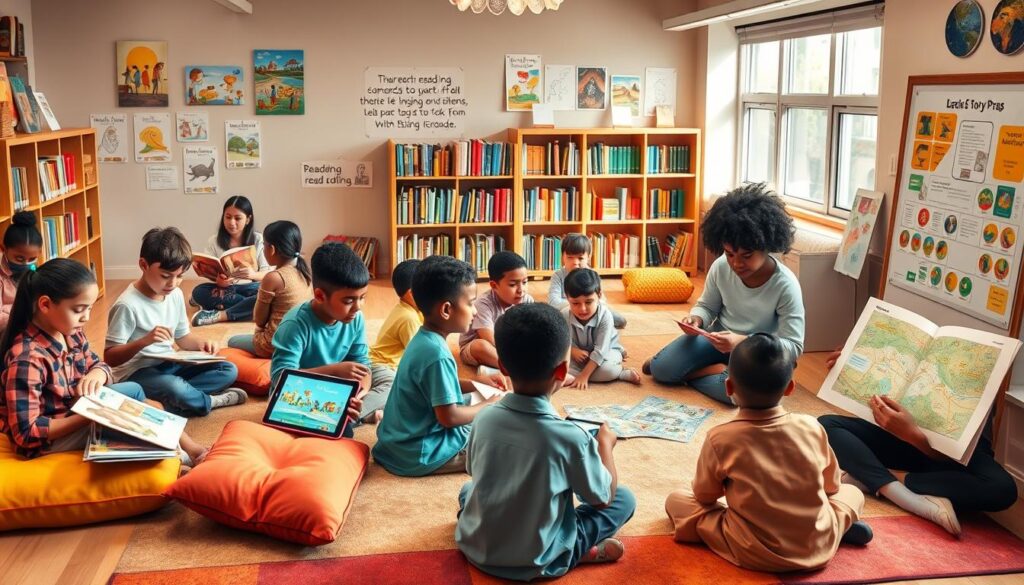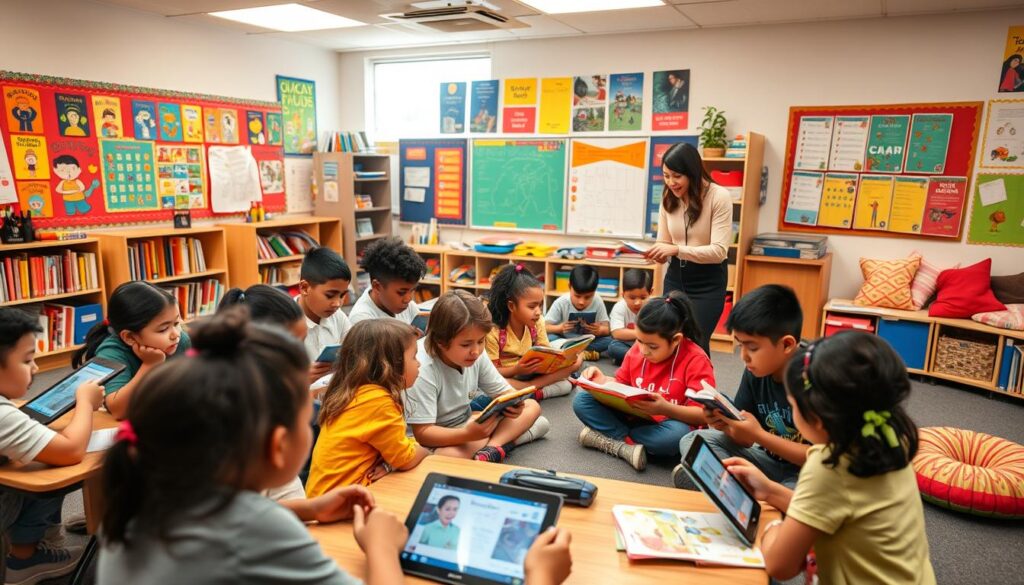Encouraging Reading in English Language Learners
As an educator, your main goal is to make your students love reading. This is especially true for those learning English as a second language (ELLs). Helping ELL students read well is key to their success in school and learning English.
By making reading fun and supportive, you can help them overcome reading challenges. This way, they can discover the amazing world of literacy.
In this article, we’ll share effective ways to encourage reading in ELL students. We’ll look at how to understand their reading challenges and how to help them. We’ll also talk about creating a reading environment that supports their learning.
فهرس المقالة
Understanding the Challenges of Reading in a Second Language
For English language learners (ELLs), reading in a second language is a tough journey. They face many obstacles that make reading hard. These challenges affect their language skills.
Common Obstacles ELL Students Face
One big challenge is moving skills from their first language to English. Even if some things are similar, English has its own rules and words. Also, not knowing cultural references and idioms makes reading harder.
Impact of Native Language on English Reading
The native language can help or hurt ELL students’ English reading. If their first language is similar to English, they can use what they know. But, if it’s very different, they might struggle with pronunciation and word order.
Cultural and Linguistic Barriers
ELL students also deal with cultural and linguistic barriers. These barriers come from different norms, education, and experiences. Not having chances to practice outside class also limits their reading skills.
To overcome these challenges, we need a plan that meets ELL students’ needs. We should use their strengths and create a supportive learning space. This will help them improve their reading and language skills.
“The ability to read is essential for success in academics and life. For English language learners, developing strong reading skills can be a significant hurdle, but one that with the right support and strategies, can be overcome.”
Creating a Supportive Reading Environment for Language Learners
Creating a warm and engaging reading space is key for English language learners (ELLs) to succeed. A positive atmosphere and easy-to-use resources help ELLs enjoy reading and improve their language skills.
Setting up the classroom is important. Make it a place where students can learn together and enjoy reading. Have a cozy reading corner with books, dictionaries, and literacy tools. This spot can spark ELLs’ curiosity and love for reading.
- Use visuals like word walls and pictures to help with language learning.
- Show off students’ work and quotes about reading to boost their confidence and pride.
- Encourage students to talk about what they read with each other.
Also, offer digital reading strategies and interactive reading activities for different learning styles. Tools like audiobooks, e-books, and language apps can make reading more fun and engaging for ELLs.
| Supportive Reading Environment Elements | Benefits for ELLs |
|---|---|
| Inviting reading nook with leveled books and resources | Fosters a love of reading and exploration |
| Collaborative learning opportunities | Encourages peer support and language practice |
| Technology-driven reading strategies and activities | Caters to diverse learning styles and enhances engagement |
By making a supportive and engaging reading space, you help ELLs overcome language challenges. They gain confidence and develop a lifelong love for reading in English.
Essential Strategies for Encouraging Reading in English Language Learners

English language learners (ELLs) face many challenges when reading in a second language. It’s vital to give them strategies to help them improve. These strategies cover three main areas: before, during, and after reading.
Pre-reading Activities
Before starting to read, it’s important to get ELLs ready. They need to use what they already know, make guesses, and know why they’re reading. Some good ways to do this include:
- Looking at the text beforehand to find out what it’s about.
- Doing exercises to learn new words and ideas.
- Guessing what the text might be about based on what they already know.
During-reading Support
While they’re reading, ELLs need help to understand and stay interested. Here are some ways to help:
- Using tools like graphic organizers to help them organize what they read.
- Showing them how to read by pausing and asking questions.
- Helping them figure out new words by looking at the context.
Post-reading Engagement
After reading, it’s important to keep ELLs involved. This helps them understand better and connect with the text. Some ways to do this include:
- Starting discussions to share thoughts and ideas.
- Asking them to write about what they read to show they get it.
- Helping them use what they learned in real-life situations.
By using these strategies, teachers can make reading fun and helpful for ELLs. This helps them get better at reading, learn new words, and understand what they read.

Selecting Appropriate Reading Materials for Different Proficiency Levels
As an educator working with English Language Learners (ELLs), picking the right reading materials is key. It’s important to find texts that match their current skill level. They should also spark their interest in different cultures and literature.
To help ELLs get the most out of their reading, consider these points:
- Text Complexity: Look at the text’s readability, vocabulary, and sentence structure. Make sure it fits their skill level. As they get better, introduce harder texts.
- Cultural Relevance: Pick texts that show their culture and experiences. This helps them connect and understand better.
- Genre Diversity: Introduce them to various genres like fiction, non-fiction, poetry, and more. This broadens their reading and linguistic exposure.
By carefully choosing culturally relevant literature and materials that match their skill level, you create a supportive learning environment. This helps ELLs improve their reading assessment skills and grow as English language learners.
| Proficiency Level | Recommended Reading Materials |
|---|---|
| Beginner | Simple picture books, leveled readers, short stories with familiar vocabulary and sentence structures |
| Intermediate | Adapted chapter books, age-appropriate non-fiction texts, short stories with more complex language |
| Advanced | Grade-level fiction and non-fiction books, news articles, young adult literature, and classic novels |
“Providing ELLs with reading materials that resonate with their cultural experiences can greatly enhance their language learning and overall academic success.”
Building Vocabulary Through Strategic Reading Practices

As an English language learner, growing your vocabulary is key. One great way to do this is by reading strategically. This method can open up a whole new world of language for you.
Word Recognition Techniques
Learning to recognize words is the first step in growing your vocabulary. Try activities that help you spot and understand new words when you read. Here are a few ideas:
- Analyze word roots, prefixes, and suffixes to figure out the meaning of new words.
- Use context clues in the text to guess the meaning of words you don’t know.
- Keep a vocabulary journal to jot down and study new words.
Context Clues Strategies
Learning to use context clues is a valuable skill. As you read, notice the sentences and phrases around new words. They can give you clues about what the words mean. This skill helps you understand new words without always needing a dictionary.
Visual Learning Methods
Using visual aids can really help with learning new words. Look for books or articles with pictures or diagrams. These can help you remember new words better by linking them to images.
By using these reading strategies, you can grow your vocabulary and improve your language skills. Remember, the more you practice and explore new words, the better you’ll get.
Integrating Technology to Enhance Reading Engagement
In today’s world, technology is key for teachers wanting to spark a love for reading in English Language Learners (ELLs). Using interactive reading activities and the excitement of digital tools, teachers can make learning fun and effective for ELL students.
E-books and digital reading platforms are great for engaging ELLs. They offer a huge library of content with language help like text-to-speech and vocabulary definitions. This lets ELLs explore texts on their own, boosting their confidence and sense of control.
Reading apps for language learners also make reading English fun and rewarding. These apps use games and rewards like points and badges to motivate students to read more.
Online platforms for language learning and literacy are also great for ELL reading engagement. They offer a variety of interactive reading activities, such as interactive stories and quizzes. These activities are designed to meet the needs of ELL students at different levels.
By using technology for interactive reading activities, teachers can create a lively and supportive learning space. This space helps ELLs improve their English reading skills and develop a lifelong love for reading.

“Technology has the power to transform the way we approach reading instruction for English Language Learners, making it more engaging, personalized, and effective than ever before.”
Developing Reading Comprehension Skills in ELL Students
Improving reading skills is key for English language learners (ELLs) to do well in school. By teaching them effective strategies, you can help ELLs read English texts with ease. They will also understand more deeply. Here are some important techniques to make ELLs better readers.
Metacognitive Strategies
Metacognition helps ELLs think about their own thinking. Encourage them to reflect on what they understand while reading. Teach them to pause, ask questions, and make guesses as they read. This keeps them engaged with the text.
Question Generation Techniques
Asking questions is a great way to improve reading skills. Teach ELLs to come up with their own questions about the text. These questions can be simple or more complex. This helps them connect with the content, find important points, and understand more.
Summarizing Practice
Being able to summarize a text shows strong reading skills. Give ELLs chances to summarize what they’ve read, either out loud or in writing. This helps them pull together main ideas, spot key details, and share their understanding clearly.
Using these strategies in your teaching can help ELLs understand English texts better. These skills will not only improve their grades but also boost their confidence as learners for life.
| Strategy | Description | Benefits |
|---|---|---|
| Metacognitive Strategies | Self-monitoring and reflecting on one’s own thinking processes | Enhances active engagement and awareness of understanding |
| Question Generation | Actively generating questions about the text | Promotes deeper understanding and identification of key information |
| Summarizing Practice | Synthesizing and communicating the main ideas and details of a text | Develops the ability to comprehend and articulate understanding |
Incorporating Culturally Relevant Literature
Using culturally relevant literature is key for English Language Learners (ELLs). It helps them connect with their culture and experiences. This makes reading more meaningful and supports their identity.
Culturally relevant books show the world from different perspectives. They reflect the lives of diverse communities. This lets ELL students see themselves and their stories in the books.
- Increased Engagement: When students find books that match their culture, they get more into reading. This builds a love for books and better understanding.
- Cultural Awareness: Reading diverse books helps students appreciate different cultures. It broadens their view and understanding of the world.
- Identity Affirmation: Stories that mirror their lives make ELL students feel seen and valued. This boosts their literacy and self-confidence.
By focusing on culturally relevant books, teachers make learning more welcoming. Students can explore their culture and improve their English skills.
“Culturally relevant literature is a powerful tool in the hands of educators, fostering literacy development while celebrating the diverse narratives that enrich our global community.”
Monitoring Reading Progress and Assessment Methods
It’s important to check how well English Language Learners (ELLs) are reading. This helps find out what they’re good at and what they need to work on. Using different tools to assess their reading can give you insights. This way, you can adjust your teaching to better help them.
Formative Assessment Tools
Using tools like running records and reading inventories can help a lot. They show you how well your ELLs are reading. This lets you see where they’re doing well and where they need help. You can then make plans to improve their reading skills.
Progress Tracking Systems
Setting up systems to track progress is key. This could be digital portfolios or learning management platforms. They help you see how your ELLs are doing over time. You can celebrate their successes and work on areas they need to get better in.
Feedback Mechanisms
It’s crucial to give your ELLs feedback that helps them grow. Good feedback boosts their confidence and shows them how to get better. Encouraging them to reflect on their own learning helps them take charge of their progress.
FAQ
What are the common obstacles English Language Learners (ELLs) face when reading in English?
ELL students often struggle with language transfer, cultural barriers, and reading comprehension. The English language can be complex.
How can I create a supportive reading environment for ELL students?
To support ELL students, set up a classroom with easy-to-access resources. Create a positive reading atmosphere. Use interactive activities to engage them.
What are some effective strategies for encouraging reading in ELL students?
Effective strategies include pre-reading activities to spark interest. During reading, offer support to check understanding. After reading, engage students to reinforce learning and foster a love for reading.
How can I select appropriate reading materials for ELL students with different proficiency levels?
When choosing reading materials, consider students’ language skills, interests, and backgrounds. Pick texts that match their level, are relevant, and offer diverse genres to support their learning.
What are some techniques for building vocabulary through strategic reading practices?
Techniques include explicit word recognition, using context clues, and visual learning. These methods help students remember and use new words.
How can I integrate technology to enhance reading engagement for ELL students?
Use digital tools like e-books, reading apps, and online platforms. These can make reading more engaging and support their language and literacy skills.
What strategies can I use to develop reading comprehension skills in ELL students?
Teach metacognitive skills, generate questions, and practice summarizing. These strategies improve ELL students’ understanding of English texts.
Why is it important to incorporate culturally relevant literature in the ELL curriculum?
Incorporating culturally relevant literature boosts engagement and awareness. It supports ELL students’ identity by offering relatable and meaningful reading experiences.
How can I monitor reading progress and assess ELL students’ reading skills?
Use formative assessments, track progress, and give constructive feedback. These methods help improve ELL students’ English reading abilities.






